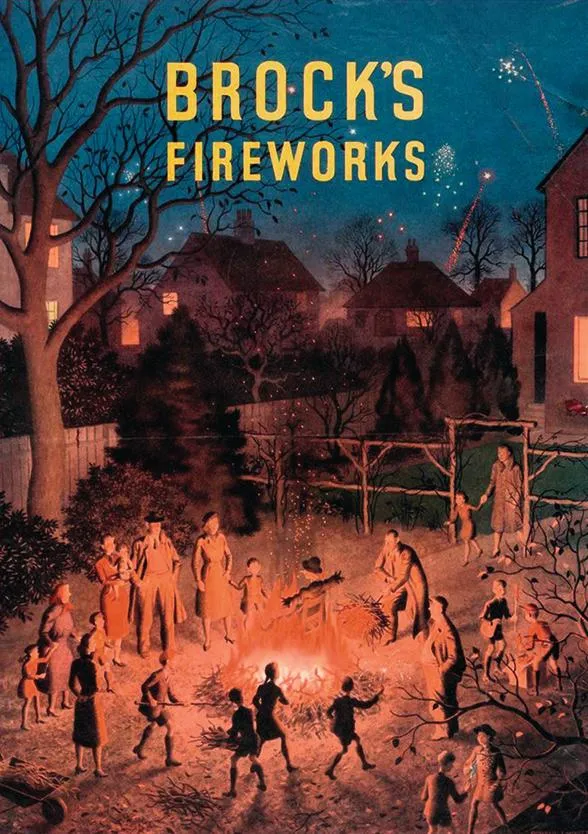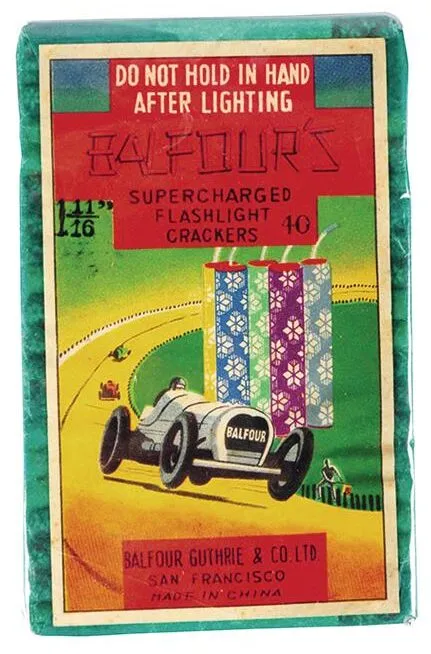Bonfire Night is very much part of the British psyche. Every year, just before the State Opening of Parliament, the Yeomen of the Guard search the cellars beneath the Palace of Westminster. It’s a ceremonial tradition that goes back to the Gunpowder Plot of 1605 and Guy Fawkes’ failed attempt to blow up James I and all parliament with him.
From 1606 to 1859, the Thanksgiving Act made it obligatory to celebrate ‘the deliverance of the King of England’ on the 5th November. Until the end of the last century, children used to make their own ‘Guys’ from old rags and stuffing, and drag them around on makeshift sledges, asking for ‘Penny for the Guy’.
The traditional Bonfire Night celebration (now in decline due to a renewed enthusiasm for Halloween), was very much a family affair. A delightful advertising poster for Brock’s fireworks shows a typical party in a suburban back garden of the 1950s: excited children, parents in trilby, Mackintosh, headscarf and beret, the night sky alight with rockets, bangers and Catherine Wheels.

Many years on, I’ve fond memories of my poor, long-suffering father running around the front lawn, lighting one precarious rocket after another from a series of empty milk bottles, as we watched from the safety of an upstairs window. Which brings me to the wonderful world of antique fireworks: posters, Chinese firecrackers, firework labels and pyrotechnic ephemera. It never ceases to amaze me what people collect.
In 2012, a packet of Balfour’s Supercharged Flashlight crackers fetched a staggering $3,835 at Morphy Auctions in the United States – a highlight from a ‘spectacular array of vintage firecrackers and pyrotechnic rarities’, the hoard of George Moyer, an American fireman, collected over 40 years.

It’s thought that fireworks originated in ancient China in the second century, when somebody threw a bamboo stick into a fire and invented firecrackers by mistake. In the spring of 1749, Handel’s Music for the Royal Fireworks accompanied a dazzling display in London’s Green Park to celebrate the end of the War of the Austrian Succession. The event ended in chaos when a stray rocket hit the wooden Temple of Peace, where 10,000 fireworks were stored. The temple exploded, killing three people.
By the 19th century, European scientists had finally worked out how to create intense colour in fireworks by the miracle of oxidation. For, of course, it’s the vibrant nature of fireworks that gave the 19th and 20th-century manufacturers the excuse to use the chromolithographic (and, later, off-set) printing process to its full glory.
Occasionally old fireworks posters come up at auction, often featuring British brands of years gone by: Pain’s, Wessex, Brock’s, Standard and Wilder’s. Standard Fireworks of Huddersfield produced a marvellous range of colourful advertising posters over the years. I’m also a sucker for the graphics of Chinese firecracker labels. These are eminently collectable, especially in America.
From the 1910s, Chinese manufacturers began to package their fireworks with imaginative and highly decorative lithographed labels. The earliest designs featured exotic beasts from mythology and legend: dragons, tigers, giraffes, camels and black cats for luck. As the century progressed, images from American pop culture and the Space Age began to appear.
Intact fireworks packages are, of course, rare. Manufacturers designed their fireworks to be blown up, rather than collected. And genuine rarity is the reason why collectors will pay seemingly crazy prices for prized items: a point worth thinking about if you’re a novice collector.
